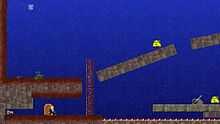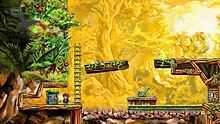Programmer art
Not to be confused with algorithmic art.


Jonathan Blow's original programmer art for the game Braid (top) compared with the game's final artwork by artist David Hellman.
Programmer art refers to temporary graphics added by the software developer to test functionality. When creating the artwork, speed is a priority and aesthetics are secondary (if they are given any consideration at all). In fact, programmer art might be intentionally bad. This draws attention to the fact that the artwork is only a placeholder and should not go into the final product. This practice might also speed its replacement.
Examples include stick figure sprites and fuchsia textures.